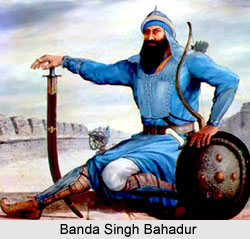 The Sikh army under Banda Singh Bahadur won several battles against the Sikh army. On 4 December 1710 the Mughal army under Rustam Dil Khan moved towards Sadhaura fort to face the Sikhs. The Sikh army attacked them with shower of arrows, rockets and musket balls. The number of dead and dying of imperial troops was so large that for a time it seemed that they were losing ground. The nephew of Feroze Khan Mewati was killed and his son wounded. The imperial army became scattered. Soon the rest of the imperial troops arrived and outnumbered the Sikhs. A fierce battle followed and many Sikhs got killed. At night the Sikhs retreated towards the eastern mountains and fell back upon the fort of Lohgarh on 5 December 1710.
The Sikh army under Banda Singh Bahadur won several battles against the Sikh army. On 4 December 1710 the Mughal army under Rustam Dil Khan moved towards Sadhaura fort to face the Sikhs. The Sikh army attacked them with shower of arrows, rockets and musket balls. The number of dead and dying of imperial troops was so large that for a time it seemed that they were losing ground. The nephew of Feroze Khan Mewati was killed and his son wounded. The imperial army became scattered. Soon the rest of the imperial troops arrived and outnumbered the Sikhs. A fierce battle followed and many Sikhs got killed. At night the Sikhs retreated towards the eastern mountains and fell back upon the fort of Lohgarh on 5 December 1710.
The strength of the Mughal armies, together with the Mughal Imperial Army and the armies under various other governors and generals taken together were approximately 2 lakh combatants, horsemen and 1 lakh non combatant camp followers. The Sikh army as against this strength could only collect less than 15,000 horsemen and footman. The Mughal armies now moved on to the other side of the bank of Som nadi facing Lohgarh. On 9 December 1710 Bahadur Shah I arrived at the site and set up his camp close to Lohgarh that had been established atop a small hill. Almost 60,000 imperial troops, horses and foot soldiers took shelter in the fort. However, the Mughls under Bahadur Shah considered Lohgarh so strong and inaccessible that they did not attack the Sikhs.
When Munim Khan arrived close to their within a shot of their entrenchments the Sikhs began a cannonade. The Wazir out of rage went against the imperial orders and ordered an attack. When some of the Mughal officials went close to the mud fort, a cannonball from a tamarind tree on the top of a hillock threw the group in disorder. Munim Khan was sure of having the Sikh chief in his power. Thus, during the time of evening prayer he ordered his troops to cease the attack and to lie upon their arms in their present position till morning. He left Rustam Dil Khan and his troops to surround the hill and the fort of Lohgarh and returned to the Royal Camp to report to the emperor the course of events.
On the night of 11th December 1710 Banda Bahadur decided to move out of the Lohgarh Fort. The Mughal soldiers resting for the morning could not obstruct their marching out of the Lohgarh Fort. Banda Bahadur and his troops escaped towards the mountains of the Barfi Raja of Nahan. On the morning of 11 December 1710, the Mughal commanders went to the fort to arrest Banda Bahadur and his forces, but found to their dismay, that they had already left Lohagarh Fort the previous night. They only found few wounded Sikhs and some families of a nearby village who had taken shelter. The wounded Sikhs were taken as prisoners to the emperor. Orders were issued on the same day to the Rajas (zamindars of Srinagar and Nahan) to seize the Sikh leader. The emperor next reached Ropar on 30 April and Lahore on 11 August 1711.
Within a year Banda Bahadur conquered and set up a Sikh state over a vast area. However, the Mughals took it back in three months` time. The Mughal Emperor Bahadur Shah reached Lahore in June 1711, but died due to some brain disorder in February 1712. The battle of succession for the throne and the weak rule of Jahandar Shah gave another opportunity to Banda Bahadur to reoccupy Sadhaura and Lohgarh and its surrounding territories in the first half of 1712. Sadhaura and Lohgarh were made ready to face a second attack by the Mughal imperial forces in the first half of 1713.



















